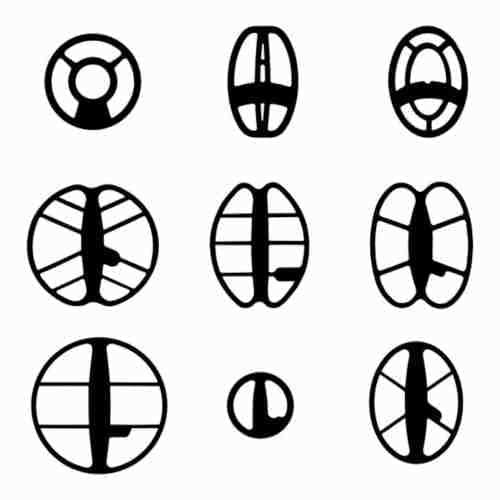
Metal detectors have been in existence since the 1800s. They work on the two concepts of electricity and magnetism. Since their invention metal detectors have evolved into several different types of metal detectors currently in existence.
Beat Frequency Oscillation
This is the simplest metal detector technology. The concept behind how it works is very easy to understand. The simplicity of this detector makes it inexpensive but also weak rather. Beat Frequency Oscillation machines can only locate metal a few feet underground. Every metal detector has the same basic structure with copper wire coiled around a steel or iron ring. The metal detectors have one large ring that is attached to the base of the detector. In addition, it has another tiny ring attached slightly higher. The coils are both connected to oscillators that can generate a frequency.
However, both of these coils operate at a different frequency. These different frequencies produce a steady tone that can be picked up by a computer or heard through a speaker. The speaker(s) usually comes in the form of a wearable headpiece. When the base coil comes across a metallic object, the interaction of electromagnetics causes interference in frequency transmission. This interference is what is used as proof of the existence of a metal object.
back to menu ↑Very Low-Frequency Detectors
Very Low Frequency is the most popular form of metal detecting technology. This is especially so among experienced treasure seekers. The detector can be highly accurate and sensitive. This coil also has a pair of coils, which work together. The first coil is the transmitter, usually giving off an intense electric current. The second coil is a receiver; it picks the signal from the main coil and amplifies it many times over.
The transmitter coil works by looping a magnetic field above and below ground. This field usually extends about two feet into the ground. The field usually stays that way until it comes across a metal object. When this happens, the object develops a magnetic current. This current then interferes with the perfect magnetic loop running into the ground. Thus, the secondary coil picks up the interference. This coil magnifies and sends into an audio system attached to the metal detector. Thus, the person is able to tell if there is an object in the ground. Each type of metal creates a different frequency so VLF detectors can not only locate metal in the ground, they can tell you what type of metal it is.
Since iron and steel are very magnetic, they produce a more powerful signal. VLF detectors can screen out these items so the detectorist does not waste time digging up junk. Even better, VLF can detect items that generate a very weak magnetic field. This includes precious objects such as gold. That is what most people using a metal detector are looking for. As a result, it would be self-defeating not to invest in such a good metal detector. VLF give the hobbyist a greater chance of discovering buried treasure.
back to menu ↑Pulse Induction
This is one of the latest innovations in detecting metallic objects. Guards commonly use this type of detectors for detecting concealed weapons at security checkpoints. However, the technology is not very efficient in differentiating the different types of metals.
This technology relies on the simple theory of echolocation. For instance, if someone were to make a sound in a padded room, most of the sound would be lost. If they to repeat the same in a room full of hard surfaces, they would experience a very powerful echo. This is how pulse induction works. The detector usually relies on one coil or a number of coils that work as one. This is unlike other detectors that rely on two complementary coils working together. Furthermore, the detector works by sending a short burst of powerful current through the coil(s).
This pulse then disappears and the magnetic field quickly reverses. This then generates a short electric current, which then disappears. The current generated is used to generate a report on the objects present in the ground. If there is a magnetic object buried in the ground, it will undoubtedly interfere with the current generated. This model works well because the pulsing motion lets it detect only signals it has generated. The greatest impediment to using metal detectors is noise from the surrounding. Although it is more accurate at detecting objects, it is very hard to differentiate these objects. PI metal detectors are some of the most expensive currently on the market.
back to menu ↑Industrial Metal Detectors
This is the most commonly used types of metal detectors for providing security. For obvious reasons, such detectors cannot be used for finding treasure. The most common industrial detector is the doorframe detector. This detector is found in most airports and secure buildings. The detector on the basic principles of electromagnetism to work. This type of detector is very effective in deterring criminals from accessing a building with concealed weapons.
back to menu ↑History of the Metal Detector
The invention of the metal detector dates back to the 1800s after the invention of electricity. They were used by gold miners during the gold rush for prospecting and also by scientists who were experimenting with finding metal in the ground.
Despite this earlier use, the invention of the metal detector is credited to Alexander Graham Bell in 1881. Bell was hired to invent a device to locate a bullet which doctors were unable to locate on President James Garfield. Garfield was shot in the back in Washington July 2nd and although he survived the attack initially he later died from the infected wound.
Although Bell had invented a viable metal detector, which was later used as a prototype for future devices, the metal springs in the President’s bed had puzzled the device and the bullet was not located. Although the first devices were large in size, featuring a vacuum tube they predominately featured in both WWI and WWII to locate land mines and unexploded bombs.
back to menu ↑Gerhard Fischer
During the early 1900s, a research engineer named Gerhard Fischer was trying to limit the distortion of ore-bearing rock on aircraft radio detection finders. This research led him to develop a portable metal detector, an idea that he shared with Albert Einstein. Fischer was granted a patent and he founded Fisher Metal Detectors, one of the leading manufactures of metal detectors in the world today.
back to menu ↑Further Development
The hand-held metal detector has seen continued development since the patent was granted to Fischer in 1925. Charles Garrett founder of Garrett Metal Detectors played a major part in this development having taken up metal detecting as a hobby in 1960. Garrett became frustrated at because he could not find a metal detector that worked exactly the way he wanted. In the end, he decided to invent his own, developing search coils and eliminating oscillator drift, a technology he was to also patent.
back to menu ↑What to Look For In Metal Detectors?
For most hobbyists, they usually look for the price as their main consideration. However, this should not be the case. The price difference between an effective detector and a plaything is not very great. It can be a great way to turn a hobby into a serious craft if one has a good metal detector.
back to menu ↑Conclusion
Traditionally, the local hobbyist shop used to be the place to find a good detector. Although this may still be so, it is advisable to do a bit of online shopping. These online stores have an unlimited capacity because they are so many. As a result, one is more likely to find better options online. In addition, most shops have an online presence. This means one can get detectors with features they may not be able to find at the local store.
Find the right metal detector, then find your treasure!










